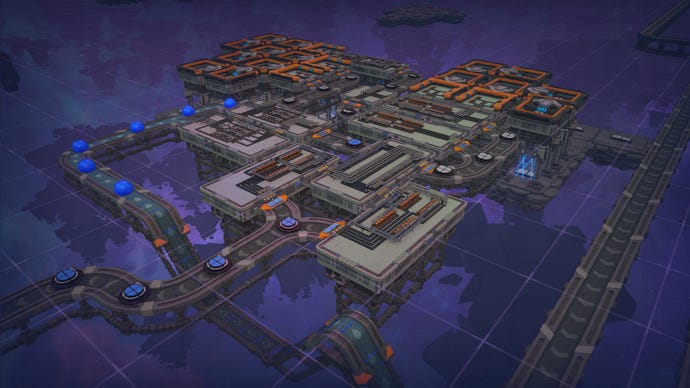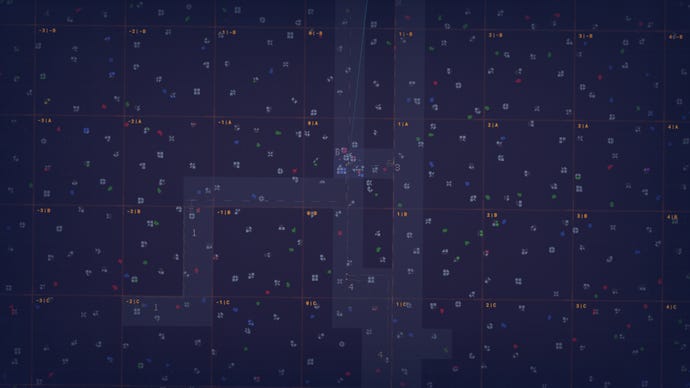Over 2000 hours in various factory games makes me a bit of a purist. In theory then, I should be the ideal reviewer to enjoy Shapez 2. But I’m also the ideal reviewer to tear it apart for the smallest of problems and flaws. I’m the Anton Ego of factory games. I don’t like food, I love it. If I don’t love it, I don’t eat it.
Alas, you needn’t worry. This is by far the most enjoyable game I’ve ever experienced reviewing, and Shapez 2 has, at least in my eyes, turned the holy trinity of factory games (Factorio, Satisfactory, Dyson Sphere Program) into a holy quartet. Its stripped-down, everything-is-free-forever approach is quite liberating, and I’ve never had so much fun placing conveyor belts in my life. But with 40 hours in my save file, I’ve often found myself wishing for a little more creativity in the challenges, a few more surprises thrown my way.
Manage cookie settings
If you’ve played a Factory game before, you’ll know the drill in Shapez 2, and you’ll get used to the rhythm of slicing, rotating, and combining shapes very quickly. Life begins at the center of the world, where a giant, shape-hungry vortex lives. It wants you to feed it circles, so you place a couple of extractors on the nearby circle deposit, sending your new shapes like an assembly line straight into the vortex’s maw. Ding! The vortex has had enough of circles now. It wants squares. So you connect a series of nearby squares. Ding! Now it wants semicircles, so you must perform your first shape manipulation by cutting some of those circles in half. Ding! Now the vortex is craving semicircles attached to rectangles. Ding! Now a circle on a square. Ding! Now the circle is red and the square is blue. Ding! Ding! Ding!

You get my point. There are two big differences between Shapez 2 and other factory building games. First, there’s the sandbox nature. There are no enemies to contend with, and buildings don’t cost resources, so you can build or demolish as many conveyor belts and buildings as you like. Second, there’s the abstraction of the factory’s products and goals. In Factorio, you build circuit boards, gears, plastic rods, all with the end goal of building a rocket to fly away from the hellish planet you crashed on. In Shapez 2, you build shapes for no other reason than to feed an ever-hungry vortex that wants to eat shapes.
Creating shapes for an insatiable abyss means that the game is constantly throwing tasks and milestones at you, like being able to paint shapes different colors or using trains to transport shapes across great distances, so you feel driven by the intrigue of not knowing what you’re going to do next. But even so, you do feel like things slow down a little as the milestones keep coming, as I was hoping for a few more unlocks that would really get my brain working.
Whether these differentiators are appealing or off-putting is entirely subjective. I don’t have a problem with the level of abstraction; in fact, I find it very intuitive. In other games, you have to hover over a circuit board to figure out how to make it. In Shapez 2, you can clearly see – oh, okay, so that’s a square below, with opposite quarters of a circle above. Cool. This sandbox approach means that many of the problems you encounter in games like Factorio – running out of resources, defending against enemy attacks, exploring the world for new areas – don’t exist here and will appeal to some players. But I don’t think the game goes far enough to replace those problem-solving moments with other dilemmas.

Still, the game has evolved tremendously since I played the Next Fest demo, not just in terms of scale but also in terms of complexity. One criticism I had of the demo was that completing tasks automatically improved the efficiency and throughput of your conveyors and factory buildings. Sounds good on paper, but in reality it’s damn annoying for people who care about carefully constructing a building based on throughput levels, only to see those levels change a few minutes later. With the Early Access version, however, non-milestone tasks will give you research points that you can spend as you like on improving the efficiency of various buildings – and also unlocking entirely new buildings and features. It’s a well-implemented system, and an excellent change that puts control of production rates squarely in the player’s hands, where it belongs.
A slightly bizarre design decision is that Shapez 2 makes all buildings and conveyor belts free, but at the same time attributes currency to copying and pasting blueprints and placing platforms. Shapez 2’s procedurally generated worlds are huge and – unlike in Shapez 1 – mostly space, which you can’t build on. To reach faraway “shape asteroids” and mine more interesting shapes, you need to place more platforms, like the one that houses your central vortex, thus increasing your area for factory construction. The game’s tutorials also encourage you to pre-build platforms for a specific purpose. For example, I spent some time putting together a platform that would take eight full conveyor belts of a shape, bisect them all in the middle, and then output the two halves in different directions. After that, I could just copy and paste that platform whenever I needed it. Well, as long as I had the blueprint points to paste into and some extra platforms to place.


It’s a weird, slightly convoluted mix. On the one hand, the things that normally cost resources in these games, like buildings and belts, are free. On the other hand, things that are normally just completely free quality of life things, like copying and pasting a blueprint, have a price. Back when I played the Next Fest demo, I liked the idea of having an extra objective in the background to grind away at, but now I’m not so sure. Mainly because the balance with the cost seems completely insane anyway. You get blueprint points by inputting certain shapes into the vortex, and maybe I was just being a bit too proactive, but I always had several million blueprint points available, and even the most expensive copy and paste jobs only cost a few thousand at most. It seems like some rebalancing is in order here.
But it’s easy to forget little things like that when you’re in the middle of a big mold-making project. In my current save file, I’m working on a factory that produces over 4,000 of a particular milestone mold per minute. After you’ve completed the last mold of a milestone, you can continue producing that mold and send it into the vortex to increase your operator level, which is mostly for showing off, but also earns you some research points, blueprint points, etc. for your effort. It’s a nice touch that’s both celebratory and motivating.

And when you unlock the final milestones, the milestone shapes are randomly selected and the game encourages you to use logic and circuitry to create what is called a Make Anything Machine (MAM) – the ultimate step in automation. Now That is I want more of this fascinating increase in complexity throughout the game and hope to spend a lot more time with it.
This is especially true considering the game recognizes that satisfaction is the bedrock of the factory genre, and leans heavily on it. Dopamine is a byproduct of nearly every building in the game, with wonderfully charming animations showing the shapes actually being torn apart, rotated, and stacked on top of each other. Some of this small-scale refinement is lost as you build out your factory to a certain size, and most of the time you’ll be zooming out and copying and pasting entire platforms at once, rather than individual buildings and belts. Once you reach this stage, however, you’re already firmly in the clutches of the game’s siren song of mass production and automation.
Shapez 2 is a different kind of factory game than I’m used to, but executed at times to a near-master level, making it very easy to dive in and try something different. Minor balance issues aside, everything feels incredibly tight, with a big emphasis on comfort, user experience, and satisfaction. I just hope that the depth increases as Early Access progresses, with more types of challenges built into later factory processes and more reasons to push further.




